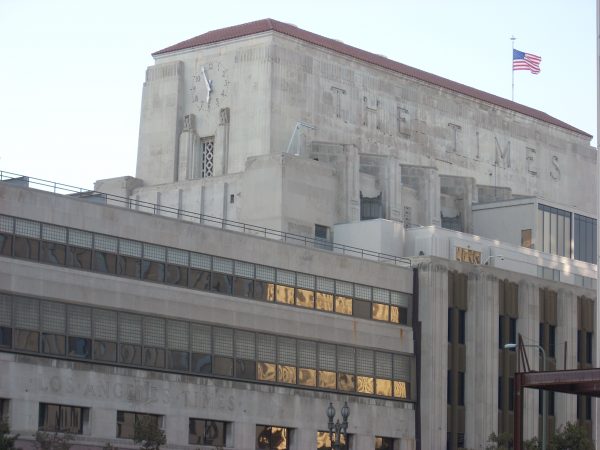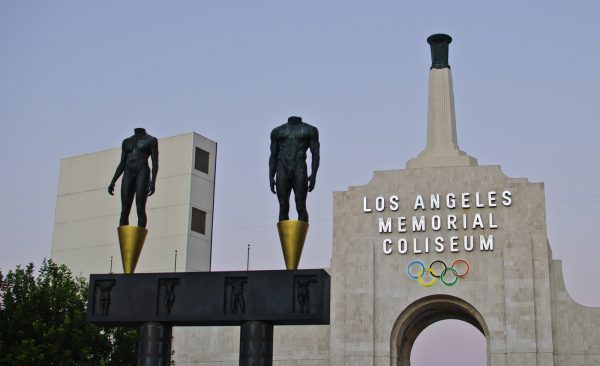[alert type=alert-white ]Please consider making a tax-deductible donation now so we can keep publishing strong creative voices.[/alert]
Did you see that recent New York Times article about the Los Angeles Times? The one that spends the first two paragraphs summarizing Colonel Otis and the city’s beginnings and then arrives at the “slow decline” of the paper? I expected this was the top of a story about media in Los Angeles, which I thought was a reasonable expectation given the abrupt recent shutdown of LAist, the hostile mass-firing/replicant takeover at the LA Weekly, and the LA Times newsroom’s very recent decision to unionize (referenced minimally as “turmoil”).
But the news/media environment, past or present, is not really the subject of the story. It is just a frame for the evergreen retelling of the city’s failure to unlock World Class City status. (Expressed here by ex-mayor Antonio R. Villaraigosa, who calls LA a “global city,” but I felt like he meant it in the aspirational, “if you can dream it, you can be it” kind of way.)

Writers Tim Arango and Adam Nagourney note in the NYT piece, brutally headlined “Paper Tears Apart in a City That Never Quite Came Together,” that there are fewer Fortune 500 companies in LA than in 1987. (Okay, but on balance, reality TV, video-game production, Snap?) They tell us Eli Broad has retired. (Good for him! But few of his 4 million neighbors will have to adjust their calendars.) Commenting on the problems facing the press/media in LA, the article quotes Donna Bojarsky expressing surprise that she isn’t seeing more “public outrage”—the kind of outrage you might find in “other cities.”
It turns out this has not been a story covering LA or its media, but a question: Who wields power in the city today? The Otis LA Times was powerful and helped the city accomplish big things, but between Eli Broad retiring and Tronc struggling, the city has a tough time tackling the types of projects “that will benefit the community as a whole,” according to a quote from former deputy mayor Austin Beutner. So, sure, there are sports teams and museums and stuff, but that doesn’t matter. LA is simply too vast and titans of industry too few.
The community as a whole? Projects like what? And more important, are readers supposed to take as a coincidence how closely this “not quite a real city” style of attack echoes what Steve Mehr, an investor in the newly awful LA Weekly, told the LA Times in December? “We don’t have a cultural scene on par with New York and San Francisco,” he said. “We want L.A. to rise to that level and create a sense of community around it.”
Ah, there’s that word, community. Or rather, “Community.” It appears seven times in the NYT piece.
When anyone suggests that shaping millions of people into a single community is a reasonable goal, be wary.
When someone endeavors to make 4 million people into a certain kind of community, on par with their tastes or some other city—and the first approach to shaping that community is to buy a newspaper and fire its staff without revealing the names of the new owners—be more than wary.
I’m going to hazard a guess that there will be much more written in coming months about “community building” and “coming together,” in the LA Weekly, and that the NYT article and Mehr’s comments are in line with momentum that is already gathering, somewhere far from public view, to construct the kind of public-private government sub-assembly that exists in other “global cities.” (Cities which, like Los Angeles, also happen to be facing housing affordability crises.)
Neoliberalism helps businesses and governments to essentially package a city as a product, and in this process they impose a specific aesthetic, brand and cost basis onto the residents of that city…so that tourists can count on a relatively standardized, repeatable consumer experience that aligns with whatever experience they were led to expect. Many New Yorkers feel their city is being dulled and sanitized by the heavyhanded interventions that are required for this type of economy to prosper. If reporting that attacks LA’s community/culture/people is an attempt to assert that a comparable neoliberal structure doesn’t yet exist in Los Angeles, speculators must be frantic to create it because the Olympic games—and its international spotlight—are 10 short years away.

I moved to Los Angeles in 1987 and left in 2010. Leaving didn’t have anything to do with a lack of civic connective tissue, “vastness” or anything else. And I will happily go back, as soon as I am willing to pay twice my current rent. In 1987, Los Angeles was not New York or San Francisco, but it was a global city that was incubating MTV-friendly hard-rock/heavy-metal bands by the dozens. Hundreds of musicians desperate to be the next to breakthrough spent their weekends blanketing Sunset Strip from the Whisky A Go Go to Doheny with handmade flyers. For a hundred years, kids around the world have dreamed of moving to Hollywood, hoping for a chance to witness and perhaps become part of its legacy, not just in music but every creative profession.
Just last month, Los Angeles writer Lynell George won a Grammy for her notes for the box set “Otis Redding Live at the Whisky A Go Go: The Complete Recordings.” The 1966 recordings, released last year, offer testimony of Redding’s talent and George’s talent—as well as one venue’s 50-plus years of enduring relevance within both the music industry and the cultural life of Los Angeles. (For transparency, I worked at the Whisky in the ‘90s. It was thriving then, too, showcasing the stars of yet another generation.) But the Whisky is one business within one neighborhood; the NYT says Los Angeles County comprises 88 cities. It does not need to mount a defense of its cultural virtues, and no demand that its culture rise to any singular idea can be taken seriously.
Besides, the claim that big things can’t get done in LA is ridiculous. How else to explain the subway, or those luxury-box monstrosities cluttering the Hollywood skyline, construction cranes as ubiquitous as palm trees, “Silicon Beach,” the emergence of residential life in downtown Los Angeles—and, my god, have you seen Eagle Rock!? Gentrification does not grow without institutional fertilizer.
Yes, there are problems in Los Angeles, but I doubt these arise because there are too few power-brokers working with government officials on the kinds of deals that the public hardly reads a whisper about anyway until the ink is dry.
In fact, homelessness and gentrification are the most visibly dire and immediate “big” challenges that I see when I visit, and the people who are profiting from all the building and gentrifying don’t seem to prioritize bringing down housing costs or solving the problems created by their personal successes. Throwing more money or philanthropic funding at the problem of housing quantity will not change a fundamental dilemma: the rent is too high, wages are too low, and thousands of people who call the city their home have nowhere to go, and no money to get there if they did.
Is it possible that Los Angeles being diverse and vast and difficult to pull together for one goal is a made-up problem invented by some of the investors who are bringing the Olympics to town and prefer to do so to their greatest possible benefit? Is it possible that “bringing a community together” and “building culture” is just vapid myth-speak from developers who view a weak media landscape as an opportunity to imprint a singular identity, a product identity, onto the city itself?

The Olympics is a “big project” that drastically renovates host cities, usually in 7-year ramp-up periods, and typically by stepping on little people (in the name of Big Ideas and promises of prosperity for workers, vendors). Death by a thousand cuts from traffic to rent increases lead some host-city-dwellers to complain that, on balance, maybe the Olympics isn’t really worth the headache and the expense.
It’s true the media landscape in Los Angeles reflects a lack of competition in the news, but civic life is not dead. A billion-dollar bond issue was recently approved by voters to construct housing by a wide majority. With the recent Measure H, LA County voters elected to raise their own taxes, to raise funds to provide homeless residents with services. Minimum wage is rising annually. The recent Women’s March drew thousands downtown, resisting the president and his politics. The civic will in Los Angeles is fierce.
If it’s difficult to get big things done, perhaps that is because single ideas rarely serve millions of people well, and because while reaching compromise in democracy can be messy and slow, democracy should usually win. (And don’t be trolled by New York, either, LA: New York’s Second Avenue subway has been in the works for a hundred years.)
I don’t believe a city or its institutions should act upon its residents as subjects, to impose community or unity, but that it should create and support the structures which allow citizens to create their lives and culture within its framework. Those who claim Los Angeles lacks unifying civic goals, however, must be willfully overlooking opportunities to extend their own enthusiastic support to their neighbors who have been everywhere, marching and voting, in large numbers and on many issues, to demand basic dignity and respect for all.
